Seven fellow truck campers share gut-wrenching accounts of using their rigs during wildfires, blizzards, mudflows, hurricanes, and medical situations. Their collective message is simple; always keep your truck and camper ready to go.
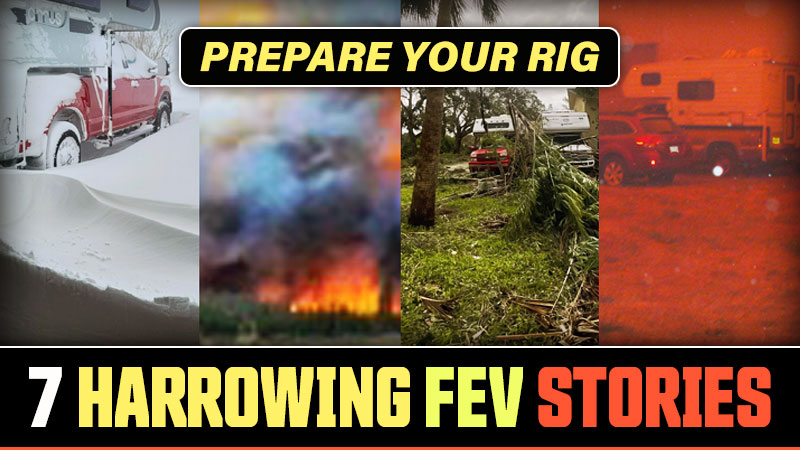
In June, we shared our personal Family Emergency Vehicle (FEV) story about Hurricane Ian. That same day we asked our readership to send in their FEV experiences.
The stories that follow are sometimes hard to read; running from sudden forest fires with horses and pets, staying alive in a camper after a radical winter storm, and keeping close to a loved one in medical danger. These are not fun truck camping stories, but they’re important, and ultimately life-affirming.
Thank you to the readers who shared their FEV stories. Your personal reports will inspire others to think about their rigs as Family Emergency Vehicles and keep their trucks and campers ready to roll.
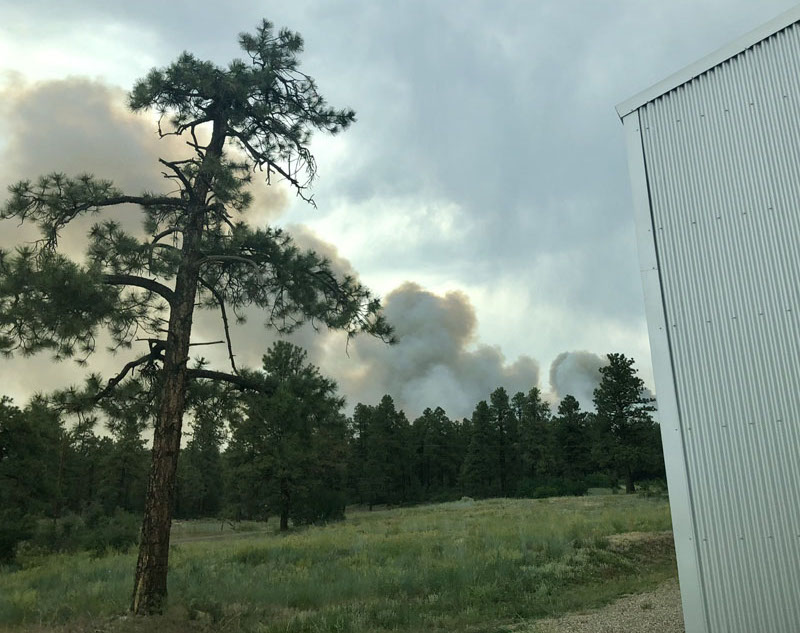
“We have used our camper many times over the years as an FEV; running from a tornado while visiting my uncle in Kentucky, when our dads were sick and in hospice in 2019 and 2021, and to cook and hang out comfortably when the electricity goes out.
Our Northstar camper lived up to its Escape Pod name when a wildfire raged near our home and we were forced to evacuate. It was a beautiful June afternoon and our friend was visiting on vacation. We smelled smoke and, shortly thereafter, saw a plume of a raging wildfire.
Within an hour, local authorities came to tell us we had to leave. By that time we had already packed our backpacks, food, and supplies for our dogs, Pepper and Tabby, and cat, Maisie.
We first went to a nearby parking lot where we joined other neighbors with campers. Then, after it looked like the amazing firefighters were gaining on the fire, we escaped the smoke by going up into the mountains for a couple days.
We always keep the truck’s fuel tank and propane tanks full. The solar panel keeps our battery topped off. There’s a hidden emergency stash of beans, rice, Tang, Spam, and simple toiletries in the camper at all times. Those are in addition to the shelf-stable foods that stay in our onboard pantry.
We also keep extra shoes, coats, towels, sheets, and blankets in the camper along with AA and AAA batteries, candles, bug spray, sunscreen, band-aids, etc.
It’s great to have all these things not only in an emergency, but when you forget something, or if you go off into a ditch, or get stranded by mechanical issues. It’s amazing how comforting it is to have a home when the truck is being worked on.
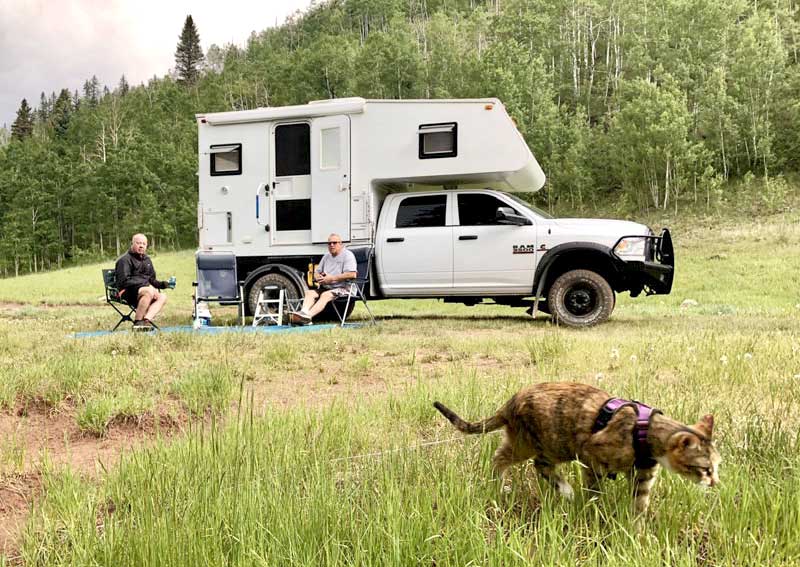
Above: Southern Colorado
Our truck camper is invaluable to our family. It’s our home away from home, both in the good times and the bad. It’s like a giant bug-out pack and second home that routinely gives us a temporary base in the most beautiful locations.
It’s also durable and capable enough to be used as a retrieval vehicle for our race truck, Jeeps, and friends’ vehicles when things break along the trail or race course.
We are so thankful to Rex and Northstar for making such an awesome camper!” – Angie Zbornik, 2013 Ram 3500, 2012 Northstar Escape Pod
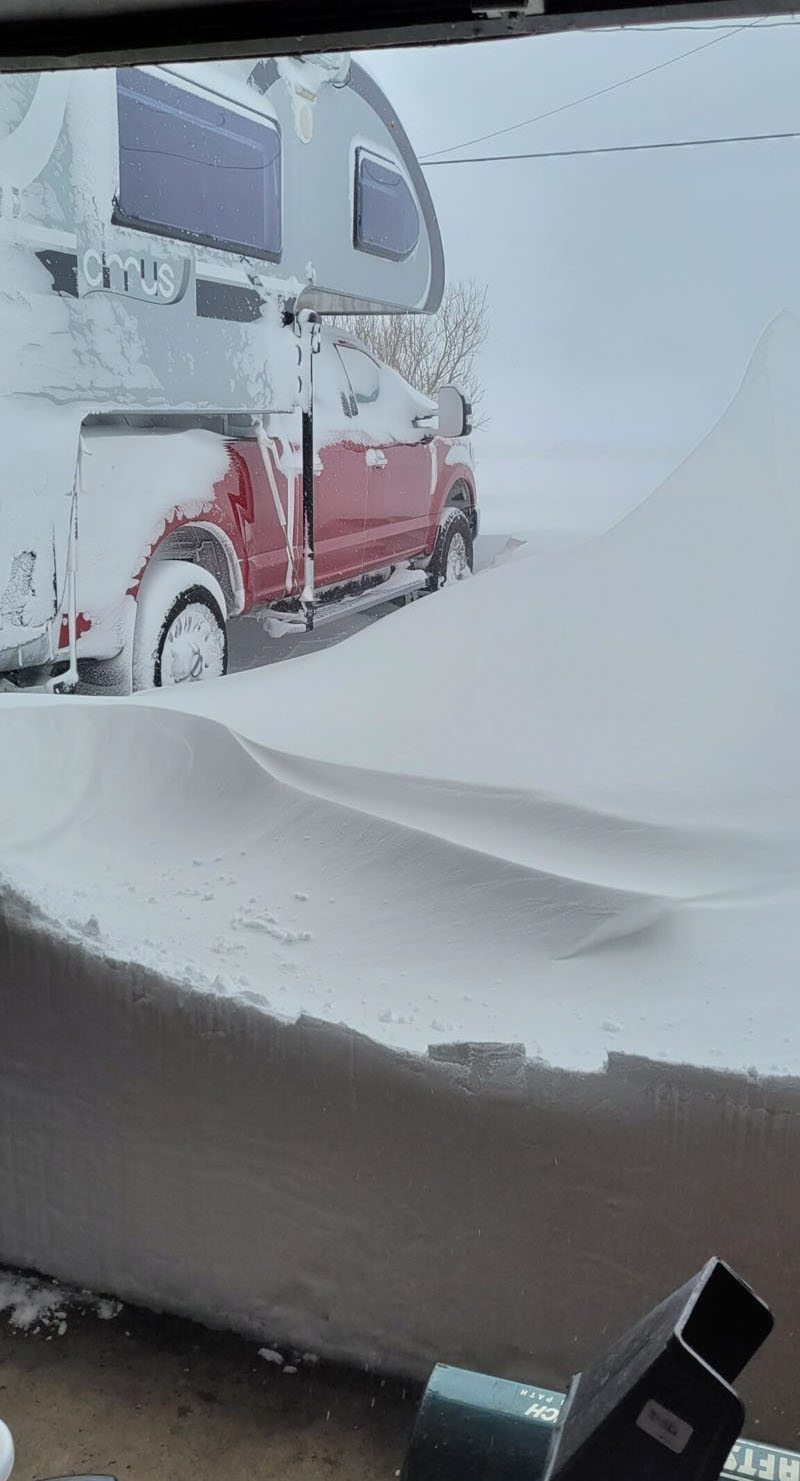
“On December 23rd, 2022, western New York had a blizzard warning. That morning we awoke to rain and our Cirrus 820 in the driveway, but it was off the truck. I mentioned to my wife that I was going to put the camper on the truck to make it easier to clear snow from the driveway. That was one of my best decisions.
Within an hour of getting the camper on the truck, the rain turned to freezing rain, and then snow. By lunchtime, we couldn’t see across the street. By dinner, the snow had covered our front door windows. This time the weatherman was spot on.
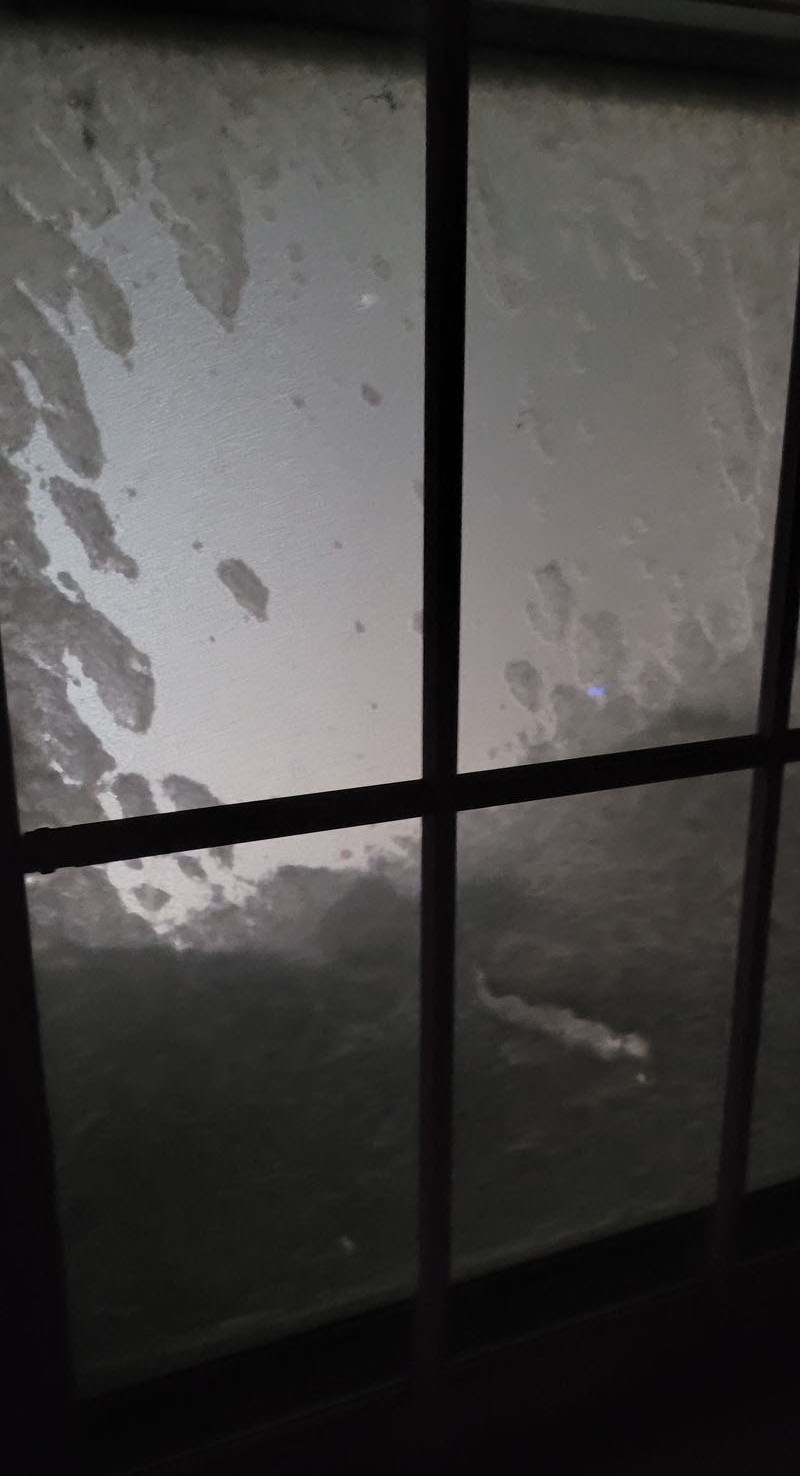
We woke up Saturday morning to a cold house. The storm had knocked out power. Our house uses a boiler that circulates hot water throughout pipes in the house. We spent the day digging out the driveway, only managing to get a truck-wide path to the street.
It was still snowing and the plow trucks were still struggling to keep the roads usable. The entire county had a driving ban, so we couldn’t go anywhere.
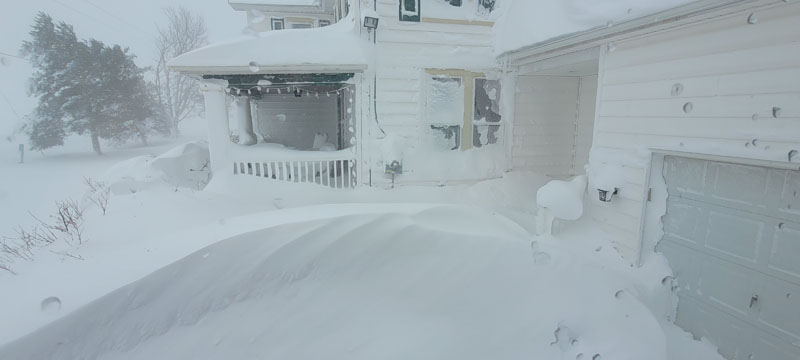
Above: This was the view out of the side window of the camper
That night, my wife, youngest daughter, two dogs and I moved into the truck camper. We camp in all four seasons, so the propane tanks were full and the inside temperature in our camper was 70 degrees.
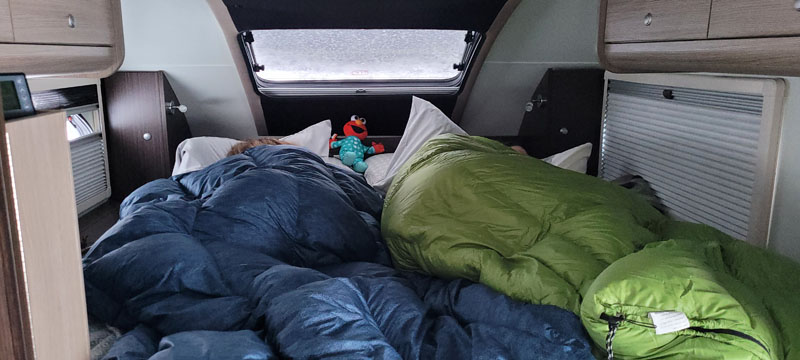
Above: My wife and daughter snuggled in the cabover
Sunday morning broke with blue skies and sunshine. When the power came back and the heat started up, we found that our heating pipes had frozen and cracked, causing a flood in our kitchen. We had to shut the water off to the house.
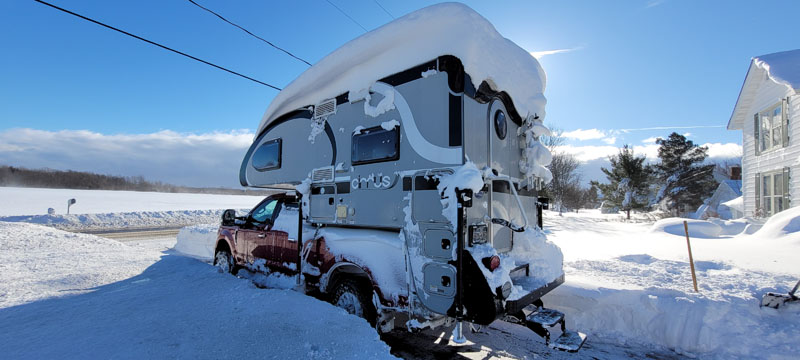
Above: Christmas was clear, cold, and sunny
Without water or heat, we had to evacuate. With a driving ban still in effect, we drove the truck over to our oldest daughter’s house and spent a week moochdocking in her driveway until the heat could be restored in our house.
Our advice is to keep your rig ready to go. We keep our camper set to 60 degrees in the winter and we have three sets of propane tanks that we can swap in as the onboard tanks get used. Our fresh water tanks are heated, though we only add water when we need it. We put a 2.5-gallon fresh water bladder in the bathroom sink and used it for cooking and washing up.
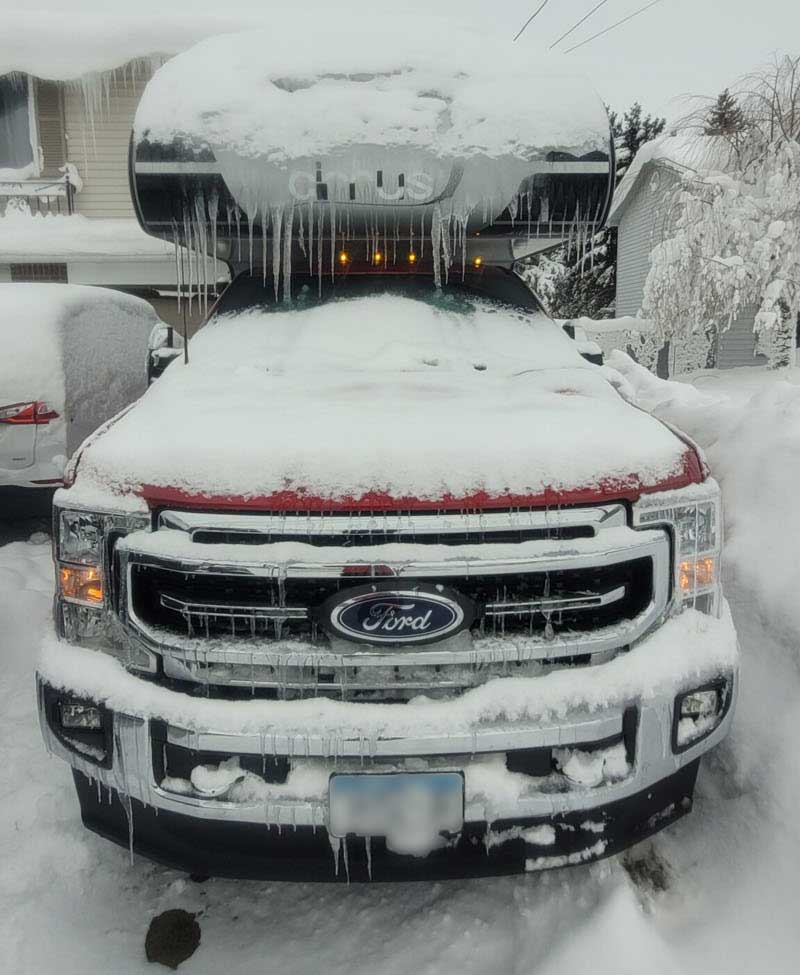
Above: At our daughter’s house
Until this blizzard, I never thought of our rig as a Family Emergency Vehicle. Fortunately for us, we were able to use it as such when we needed to. Now, it has become an extension of our house and much less of a toy for weekend use only.” – Tom Simpson, 2022 Ford F-350, 2017 Cirrus 820
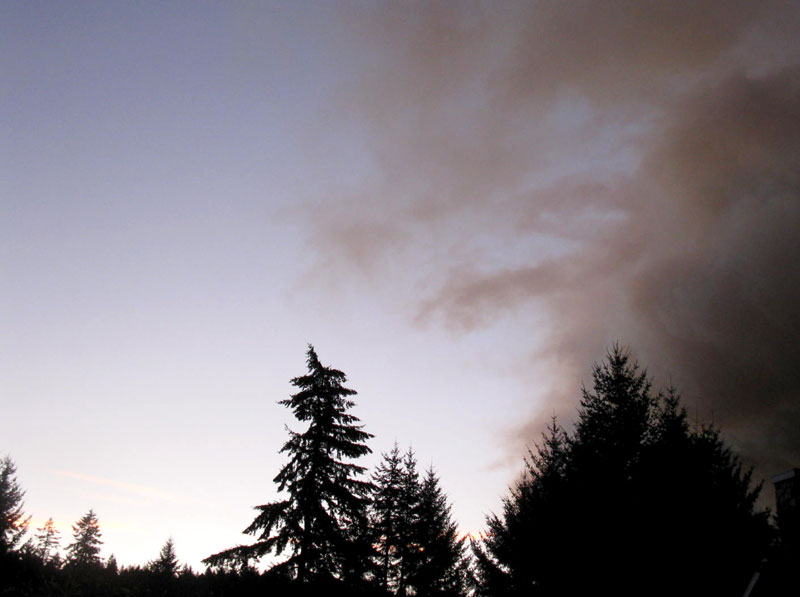
Above: Molala, Oregon
“On September 9, 2020, my husband, dog, Monty, and two horses evacuated to a horse facility due to an approaching wildfire.
We had a ‘go now’ evacuation order. The local fire department tagged our mailbox with a yellow ribbon meaning that access was difficult due to our long driveway and lots of vegetation and trees. The fire was approximately six miles from us and moving fast. I believe there were two other fires in the area. With the need to move livestock, I would have left even without the order.
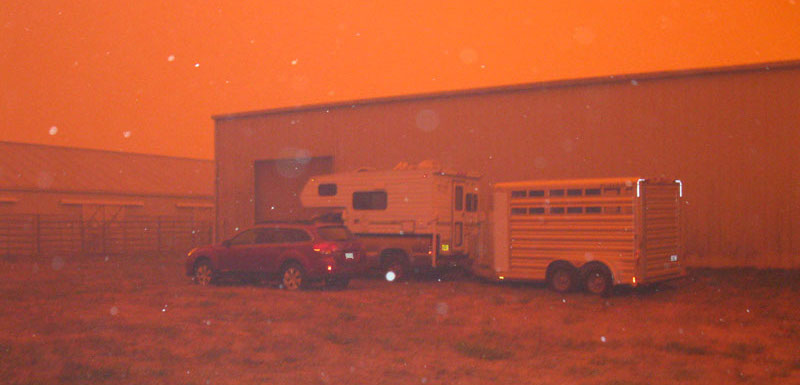
During the evacuation, we had to move again to the state fairgrounds because a different wildfire was approaching the horse ranch. Monty and my husband slept very comfortably in the cabover. Being short, I slept on the dinette bed. We were out for about six nights. When we were moved to the state fairgrounds, the local restaurants provided excellent food. Monty loved the adventure.
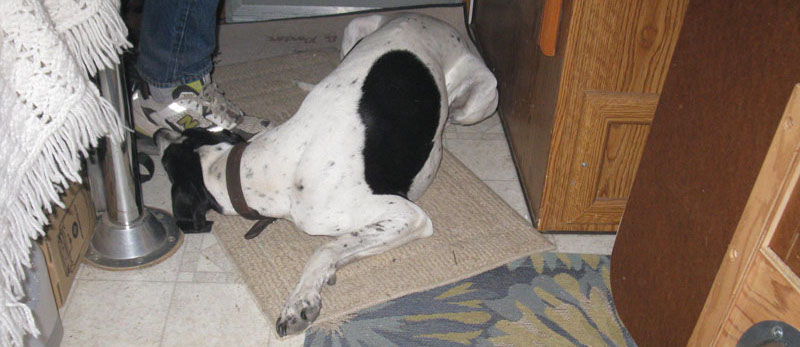
Everything was okay when we returned home. The house was smoky inside and all my water troughs were covered in ash. People with livestock should cover their tanks before evacuating.
Have everything you might need in an emergency close to or inside your camper. Keep your camper’s water tank full and your black tank emptied. We were fortunate that the state fairgrounds had the city come around with a potable water tank and septic service.
Since I camp frequently with my horse, I had all my equine supplies in a stack. You should have a current list of your absolute essentials and things you absolutely cannot afford to have destroyed; meds, legal documents, and old photos. Gather them up as soon as you hear you might have to evacuate. Keep at least half a tank of gas in your truck at all times. During an emergency, you wouldn’t believe the queues to gas up vehicles and portable tanks for generators.
It is a great comfort to have a truck camper. I don’t live in a part of the state that normally has wildfires, but you just never know. Motels are very hard to come by and if you want to make sure you can stay with your pet, you need an RV.” – Julie Davie, 2002 Chevy 2500 HD, 2005 Pastime 840 LT
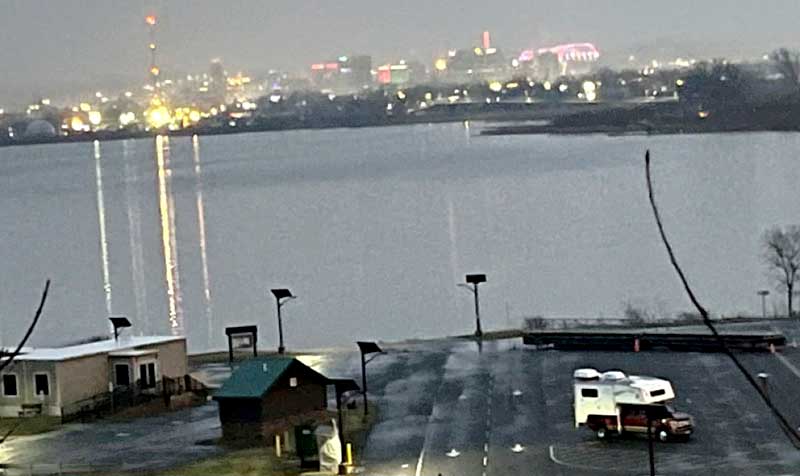
Above: Onondaga Lake, Syracuse, New York at the boat launch
“My mom needed a surgical procedure that nobody in our area could do in a timely manner. Eleven months later, we found a specialist outside our medical region that agreed she was a candidate. She would have continued to decline without the surgery.
It was supposed to an overnight, or maybe two day stay. Well, sadly, that never happened. She ended up developing complications after the initial surgery, which was successful. Apparently, there may have been too much damage due to the eleven month delay in treatment. She ended up in ICU in a medically-induced coma and on a ventilator. She never fully came out of the coma and subsequently succumbed to the complications.
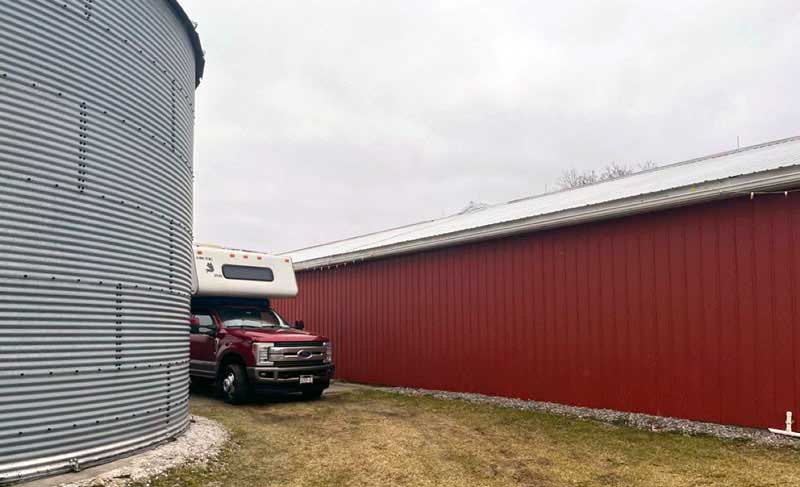
Since it was more than a three hour drive each way, we stayed at a hotel the first week. Then we found a Boondockers Welcome host. They allowed us to stay onsite in the next town over (less than a half hour away) with electric hookups. We used the electricity for our electric heater.
We were extremely blessed to have found them because they allowed us to stay there during the following two weeks. It was much more affordable than a hotel.
My only advice is to be prepared with some ability to dry camp and be prepared to deal with all sorts of weather conditions. I also recommend having some redundancy options built-n.
Thankfully we were set up with redundant systems; 520 Ah lithium battery bank, 200 watts of solar, 30 amp MPPT solar controller, 40 amp DC-DC charger, a built-in generator, 30 amp shore power option using our converter charger, and a small 750W inverter.
In that FEV experience, we had shore hookups most of the time. Otherwise we would have been using the generator as well as the DC-DC charger to run electric appliances and to keep the battery bank charged. It was winter time, so we may have needed additional propane for the furnace and stove.
Having our camper meant that we had a portable home base to return to during a very stressful and trying time. It also meant that we didn’t have to drive three hours each day. We also didn’t have to pay extremely expensive rates to stay at a hotel. Having our camper allowed us additional options that helped save us time and money. It was our familiar secondary home on wheels.” – Maria Hanby, 2019 Ford F-350, 2003 Arctic Fox 990
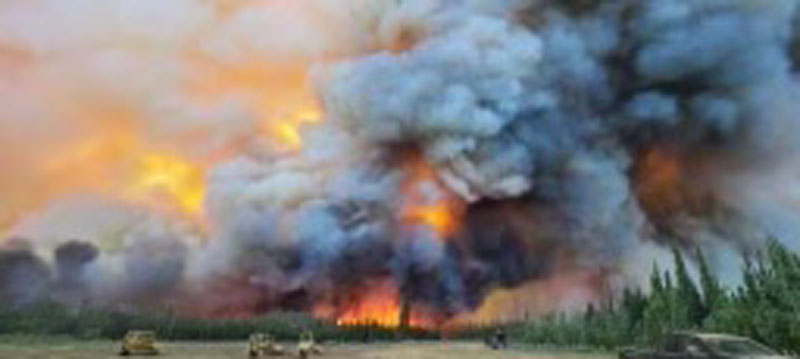
Above: Kobe Ag Road, near Clear Air Force Station, Alaska
“Last summer, my husband and I, three dogs, a cat, and two horses had to evacuate our home in Alaska for three days due to a forest fire. We moved to a gravel pit about four miles from our house. We had to camp out not only because we had horses, but also because the camper is our home away from home.
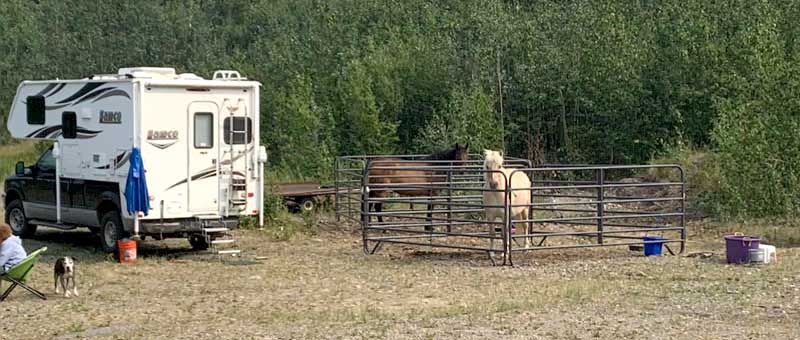
Above: Mile 273 Parks Highway, Alaska
When we returned, our entire property and one cabin had been destroyed, but the firefighters had saved our house, barn and garage by setting up sprinklers.
The fire had been burning two weeks to the west of us. The Alaska Division of Forestry is the agency that determined what areas would be considered for ‘Ready, Set, Go’. They had public meetings in the nearest town about 20 miles from us, as well as having an information board set up at the beginning of our road, which is two miles away.
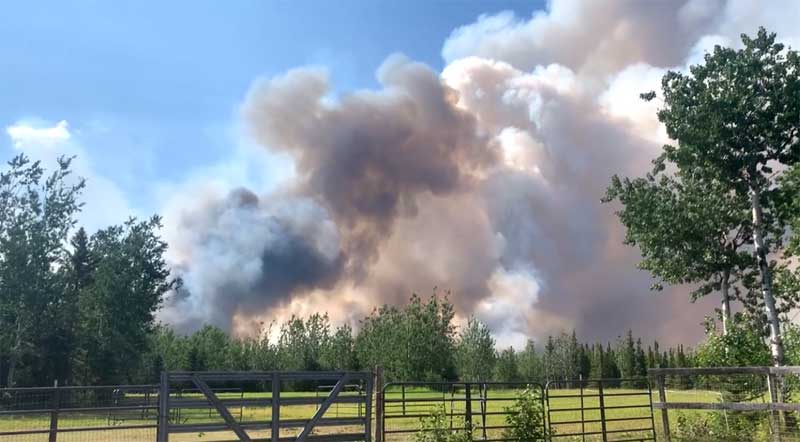
At this information board, a couple of Division of Forestry employees would meet with the locals at a set time each day if anyone was so inclined. We could also access information on our phones. And during those weeks firefighters showed up at our house several times a day with more information, to set up hoses and sprinklers, and to thin the trees around our place. Thus during the ‘Ready’ and ‘Set’ stages, we had time to plan and pack.
My advice is to prepare to use your truck and camper as an FEV. Bring along things that you would take on any camping trips. That, of course, includes anything necessary for animals that are with you. Also important documents, medications, food supplies and water should be at hand to pack up quickly.
With the protocol of ‘Ready Set, Go’ being set in place by firefighters, we had all those things packed in advance.
Due to the warning and preparation, we had choices on where to go. We did not have to stay at places where there was electricity or running water. Our most important consideration had to be the horses and, with a camper, that could go anywhere and supply all our needs without access to electricity and plumbing. We could concentrate on going to a place that could accommodate the horses.” – Charmi Weker, 1999 Ford F-250, 2014 Lance 850
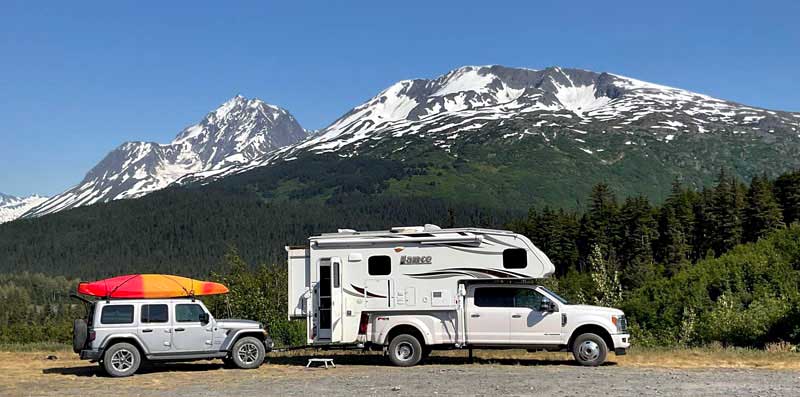
Above: Before the hurricane in Alaska
“After driving from Florida to Alaska and back last year, we arrived back in Florida the day before Hurricane Ian arrived. We didn’t expect the direct hit and also needed to help our son deal with preparation.
Right before the storm, we filled our bathtubs at the condo with water. We moved our sports car to my son’s house as he was located at higher ground. And we raised our valuables off the ground onto tables and shelves.
We thought that we might leave the next morning, but that was not feasible as the storm bore down on us. We were well stocked with food, dry goods, and frozen foods. We have a reverse osmosis water system with a 300-gallon tank, so drinking water was not an issue. We also have generators and a large propane tank.
We backed our two Lance truck campers against the garage doors at my son’s house and headed to our fourth-floor condo. The eye went directly over us and then over our campers.
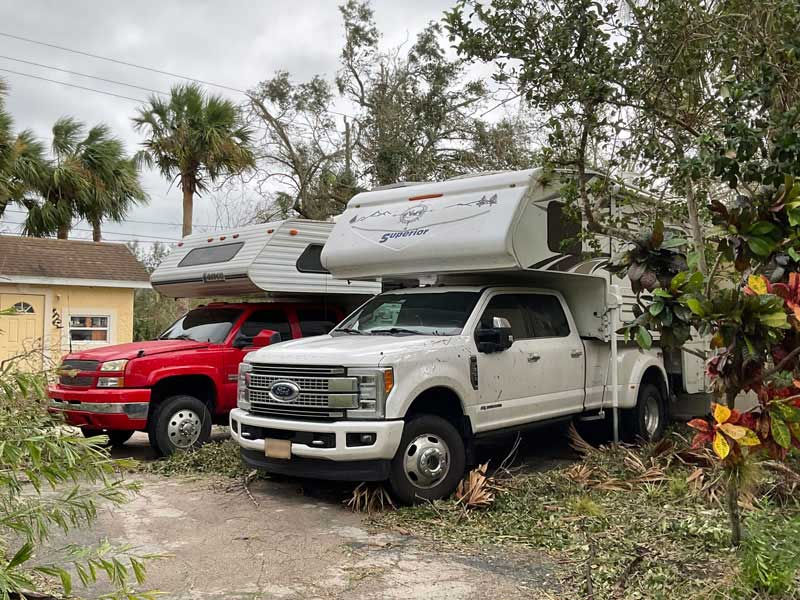
Fortunately, we did not have any significant flooding or storm surge at any of the three places. Power went out mid-hurricane and didn’t come back on for eleven days. We went to the house the next morning and began cleanup. During this time, we fired up the Honda generator and lived in our Lance.
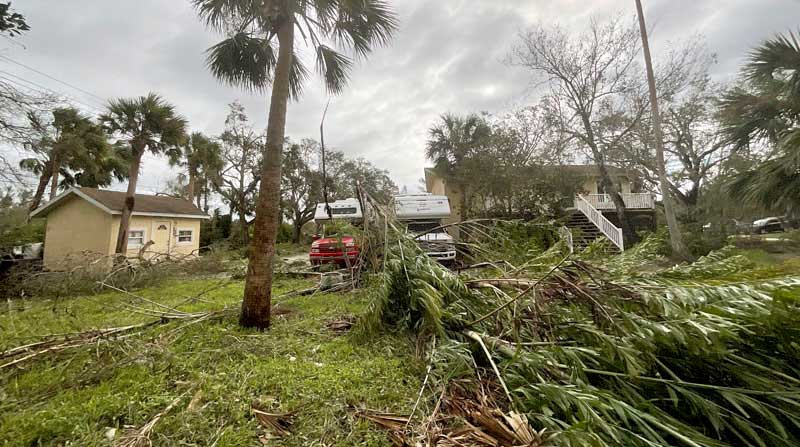
The damage was incredible and is still being cleaned up. We lost roofing on all of our buildings; condo, house and shed.
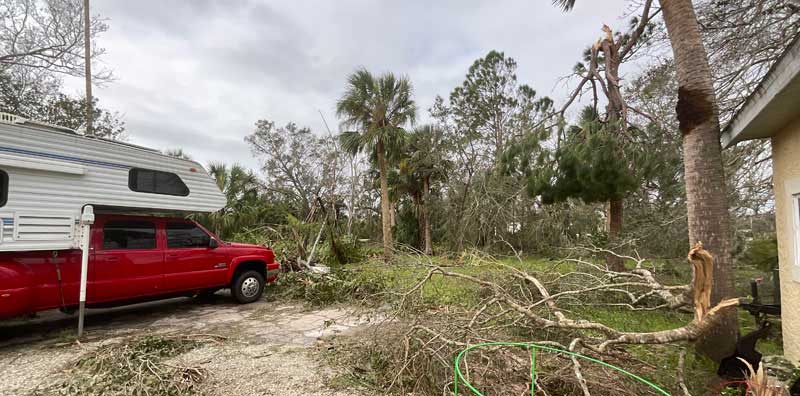
Above: Punta Gorda, after the storm
Trees were down, huge oaks tilted and debris was everywhere.
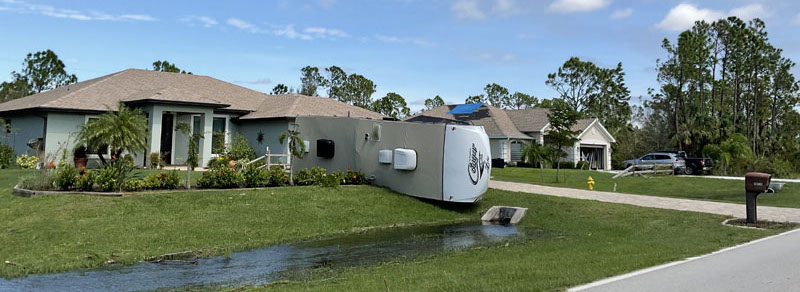
Above: A nearby fifth wheel on its side
Our advice is to have your truck and camper ready to go.
It is already a bug-out vehicle by design, so a properly stocked camper is capable of supporting you for weeks. Fresh water, propane and fuel reserves should be considered.” – Jim Quince, 2019 Ford F-350, 2016 Lance 1172
“On December 13th, 2017, the Thomas Fire completely surrounded the town of Ojai in southern California. We had already evacuated our horses and had made sure both our trucks were full of fuel and ready to pull out.
My old rig was a 1995 Dodge Ram that had hauled a 1990 Lance Camper for many years. It was hauling our horse trailer to assist in evacuating other horses if need be. The Lance is now hauled by my wife, Debbie’s 2007 Silverado, which pulled a trailer full of period reenactment camping materials. If the worst came to the worst, we had enough canvas and cooking supplies to shelter three families.
By 5:00 p.m., cinders were falling from the sky like hail and we could hear irrigation pressure vessels exploding on the hillside above us. It was time to leave.
A couple of days before, we had locked our two cats, along with a stray in the workshop, so they would be easy to catch if we had to evacuate. We keep cat and dog crates for such an emergency and it’s amazing how quickly you can stuff a cat into a crate when necessary.
The last task was to move our spare vehicles into the horse arena, parked with space between them in case the property was over run by the fire. We drove the two loaded trucks out the gate, which I left open for fire department access, and said goodbye to our home.
Debbie worked for the local water department and had to keep the water lines operating, so we relocated to the department parking lot in town. The trailers were dropped off and the cats bedded down in the horse trailer. Our dog joined us in the camper and we turned in for the night.
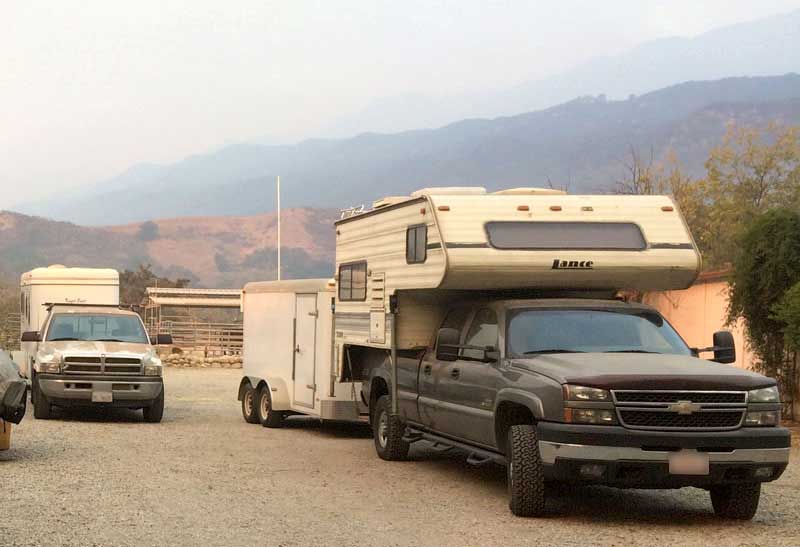
The next morning, our neighbor called to let us know that the fire had passed by, scorching the entire valley right up to our back fence. The fire crews had worked a miracle and kept the fire out of the town, with only one indefensible building destroyed on our line.
Debbie worked in the camper for the rest of the week and helped to keep the area water pressure on. I took the Dodge and went back to the property to damp down spot fires and assist the fire crews.
Our camper FEV story doesn’t end there. On January 9th, 2018, the town of Montecito was hit by mudflows in the burned areas. The mudflows closed all coastal access to the North and my job in Santa Barbara. The only way around the damage was an 8 to 10 hour drive inland. The camper came into its own again as I only had to make the drive once and set up in our company parking lot (pictured below) for the two weeks it took to clear the roads.
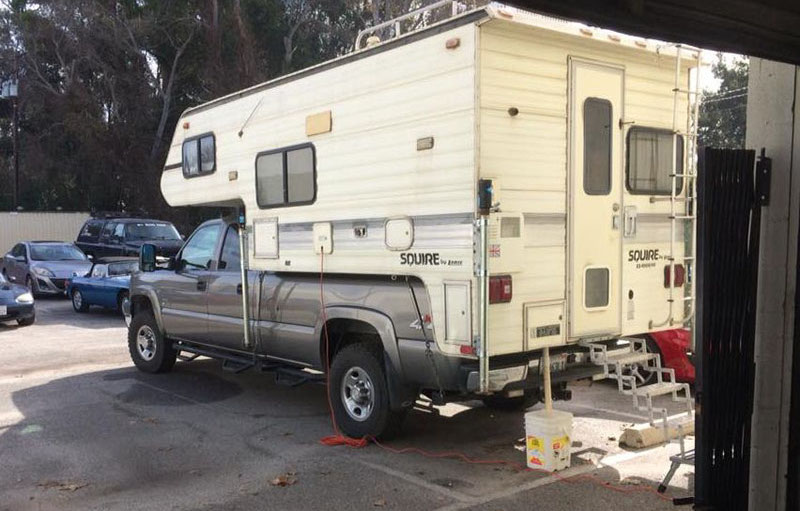
Our experience using a camper as a Family Emergency Vehicle led us to keep the Lance when we purchased a newer Bigfoot camper. The 33 year old Lance has little resale value, so it makes more sense to keep it available for use on the Dodge for rough desert trips. Fitted with multiple solar panels, it’s also a portable power station for use during power failures.
Since we tow a range of trailers, we chose shorter, wet bath campers which are a bit easier to maneuver and park. Having two such rigs gives us a lot more options in case of another emergency or evacuation.” – Kelvin Dodd, Ojai, California
Whether to escape a forest fire, flood, or hurricane, or to help a family member at home or in the hospital, a truck camper is the ultimate Family Emergency Vehicle. Read our The Truck Camper Family Emergency Vehicle article to see what you need to do to keep your FEV ready to go.
